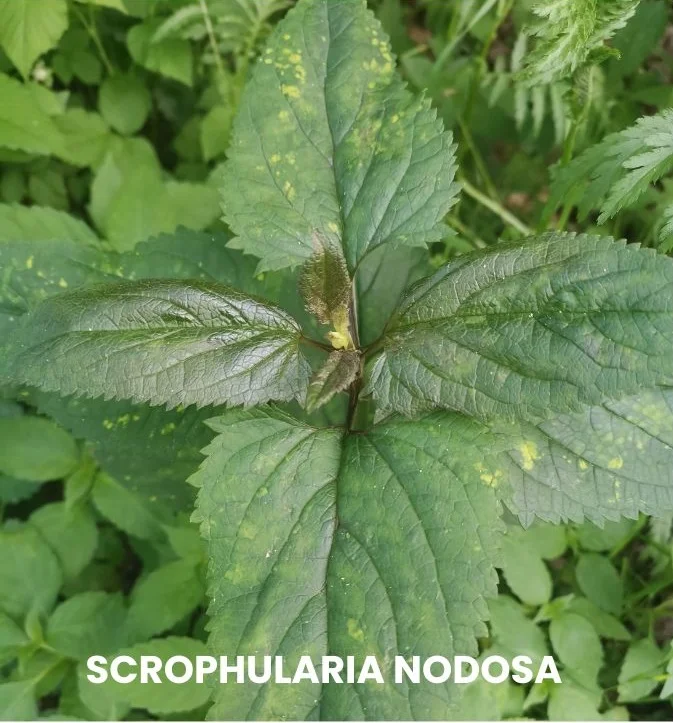Scrophularia Nodosa, commonly known as Knotted Figwort, is a powerful homeopathic remedy particularly effective for treating conditions associated with enlarged glands, such as Hodgkin’s disease.
It is widely regarded as a valuable skin remedy and is noted for its specific action on the breast, making it useful in treating breast tumors, eczema, and various glandular issues.
The remedy also shows efficacy in treating hemorrhoids, tubercular testis, and epitheliomas.

SOURCE INFORMATION
Scientific Classification
- Kingdom: Plantae
- Order: Lamiales
- Family: Scrophulariaceae
- Genus: Scrophularia
- Species: S. nodosa
Origin
- Native to Europe and parts of Asia, the Knotted Figwort is traditionally used for medicinal purposes, especially for its anti-inflammatory and detoxifying properties.
- In traditional herbal medicine, it was often applied to skin ailments and glandular swellings.
Historical Facts
- Scrophularia Nodosa has been used in European herbal medicine for centuries to treat conditions such as scrofula (tuberculosis of the lymph glands), hence the association with glandular conditions.
PATHOGENESIS
- The remedy primarily acts on the glands, skin, and mucous membranes.
- It has a significant effect on the lymphatic system and is useful in treating swollen and inflamed glands.
- It also targets various skin ailments, from eczema to ulcerations, and is effective in respiratory and digestive conditions linked to scrofulous or tubercular tendencies.
KEY CHARACTERISTICS
- Enlarged Glands: Particularly effective for swollen or hardened glands, including those in Hodgkin’s disease, breast tumors, and scrofulous swellings.
- Skin Conditions: Valuable for skin problems such as eczema, especially behind the ears, and pruritus (itching).
- Useful in treating lupus ulcers and epithelioma (skin cancer).
- Hemorrhoids: Treats painful, bleeding, and protruding piles (hemorrhoids), providing relief from discomfort.
- Breast Affinity: Specific action on nodosities (lumps) and tumors in the breast, especially scirrhous or hard, fibrous breast masses.
DETAILED ORGAN SYMPTOMS
HEAD
- Vertigo: A sensation of dizziness or spinning, particularly felt in the vertex (top of the head), and worsens when standing.
- Headache: Pain that extends from the forehead to the back of the head.
- Eczema Behind the Ears: Scaly and itchy skin behind the ear, also known as crusta lactea (milk crust).
EYES
- Photophobia: Sensitivity to light, causing discomfort.
- Spots Before the Eyes: Patients often see spots floating in their vision.
- Eye Pain: Sore eyeballs with stitching pains in the eyebrow area.
EARS
- Inflammation: Swelling and redness around the auricle (external part of the ear).
- Ulceration: Deep-seated ulcers affecting the auricle.
- Eczema Around the Ears: Chronic skin irritation and inflammation around the ear area.
ABDOMEN
- Liver Pain: Discomfort in the liver, particularly noticeable with pressure.
- Colic: Cramping pain located below the navel.
- Rectal Pain: Pain and discomfort in the sigmoid flexure (a part of the colon) and rectum, often associated with painful hemorrhoids.
RESPIRATORY
- Dyspnea (Shortness of Breath): Difficulty breathing, often accompanied by chest oppression and trembling.
- Chest Pain: Pain around the bifurcation of the trachea (where the windpipe divides into the lungs), commonly seen in asthmatic patients with scrofulous tendencies.
SKIN
- Itching: Prickling sensation and itching, particularly on the back of the hands.
- Ulcers and Nodules: Used for treating lupus ulcers, cancerous growths, and nodosities, particularly in the breasts.
SLEEP
- Drowsiness: Excessive sleepiness, especially in the morning, before and after meals, often accompanied by weariness and fatigue.
MODALITIES
- Worse: Symptoms worsen when lying on the right side, which may cause discomfort in breathing or exacerbate glandular pains.
- Better: Improvement is seen with rest and local applications, especially for skin conditions.
WHAT ARE MODALITIES IN HOMOEOPATHY?
RELATIONSHIP WITH OTHER DRUGS
Compare with,
- Lobelia Erinus: Another remedy used for glandular swellings.
- Ruta: Known for treating similar skin and glandular conditions.
- Conium: Effective in treating hard glandular tumors and similar skin ailments.
- Asterias: Useful in treating breast tumors and skin conditions.
DOSE
- Homeopathic Potency: The remedy is generally used in tincture form or in the first potency for treating various conditions.
- For skin conditions and enlarged glands, topical application may also be used.
- Common Dosage: Tincture and first potency are often recommended, but higher potencies may be prescribed based on the severity of the condition and individual response.
Frequently Asked Questions
What conditions can Scrophularia Nodosa treat?
- It is primarily used to treat enlarged glands, skin conditions (such as eczema and ulcers), hemorrhoids, breast tumors, and respiratory issues like asthma in scrofulous patients.
Is Scrophularia Nodosa safe for external application?
- Yes, it can be applied topically to treat skin conditions and enlarged glands, though internal use is often recommended for systemic conditions like glandular issues.
Can this remedy be used for hemorrhoids?
- Yes, Scrophularia Nodosa is effective in treating painful, bleeding, and protruding hemorrhoids, providing relief from pain and inflammation.
What are the key symptoms indicating the use of this remedy?
- Key symptoms include enlarged glands, breast tumors, eczema (especially around the ears), painful hemorrhoids, respiratory distress in scrofulous patients, and general skin ailments like ulcers and nodules.
Glossary of Difficult Words
- Scrofula: A form of tuberculosis that affects the lymph nodes, particularly in the neck.
- Epithelioma: A type of skin cancer arising from the epithelial tissue.
- Dyspnea: Difficulty in breathing, often associated with respiratory conditions like asthma.
- Nodosities: Abnormal, hard lumps or masses in the body, commonly found in the breasts or lymph nodes.
- Photophobia: An abnormal sensitivity to light that causes discomfort.
- Pruritus: An irritating sensation that makes one want to scratch, commonly referred to as itching.
- Crusta Lactea: A form of eczema commonly seen in infants, affecting the scalp and behind the ears.
